Design and operation
Two train sets were built with significant differences in construction. The day train, "Senator" (VT 10 501), consisted of seven cars, including the front and rear engine unit. The cars were connected by single Jacobs axles. Only the first bogies of the power units were twin-axle bogies, both axles being powered. The "Senator" was on duty between Hamburg and Frankfurt/Main from May 1954 until November 1957.
The night train, "Komet" (VT 10 551), was different from the "Senator" though its shape looked similar at first sight. Its livery was notably different. Instead of single Jacobs axles connecting the cars, twin-axle Jacobs bogies were used. The "Komet" was delivered with 7 (2+5) cars from the outset and soon afterwards equipped with an additional dining car. All available online pictures show the Komet with 8 cars (2+6). In 1956, an additional car (conference car 551i) was built for the first foreign journey by a German President after the Second World War. Due to the train's limited power, another car had to be taken out of the train in order to accommodate car 551i. The conference car is the only surviving unit. "Komet" had better driving characteristics than "Senator", which was described as behaving a bit like a goods wagon.
"Komet" was in service between Zürich and Hamburg from May 1954 until December 1960 and was operated by the DSG (Deutsche Schlafwagen Gesellschaft/German sleeping car company).
Technical data
The VT 10 501 was built by Linke-Hofmann-Busch in 1953 for the Deutsche Bundesbahn. It was designed as a seven-unit train. Every pair of intermediate cars had a common Jacobs axle; only the power cars had twin-axled, powered bogies.
The VT 10 551 built in 1953 for the Deutsche Schlafwagen- und Speisewagengesellschaft by Wegmann in Kassel and taken over on 1 January 1955 by the Deutsche Bundesbahn. The trailer cars were linked by twin-axled Jacobs bogies; the power cars had twin-axled, powered bogies.
Each power car was equipped with two MAN diesel engines of Type D 1548 G, each developing 118 kW (158 hp). Later, the power was increased to 154 kW (207 hp) per engine. The original version had a top speed of 120 km/h (75 mph); the later version could attain 160 km/h (99 mph) this speed was never used in the time table. To supply power to the train, two additional diesel engines were installed, each capable of 92 kW (123 hp). Power transmission was hydraulic with a mechanical four-way gearbox.
The different railway companies in Germany have used various schemes to classify their rolling stock.

The ICE 1 is the first batch-produced German high-speed train and one of six in the Intercity Express family. Revenue service at speeds up to 250 km/h (155.3 mph) started in 1991. It was raised to 280 km/h (174.0 mph) in May 1995 and temporary reduced to 250 km/h (155.3 mph) again, as a result of the Eschede accident.

The VT 125 is a former diesel multiple unit commissioned by the Deutsche Bundesbahn from 1953 onwards. It was commonly used with either two or three car configurations, using the VM 12 middle car and VS 12 driving van trailer. Three-car trains were usually made up of two motor units and one unpowered middle car. The trainsets were routinely made up from twelve driving cars, four control cars and 13 middle cars and used in city express services. The VT 125 was used in regional traffic, with first and second class saloon seating.

The trainsets of Class VT 11.5 were diesel multiple units built by Deutsche Bundesbahn (DB) in 1957 and used for Trans Europ Express (TEE) services. Perceived as flagships of the DB rolling stock, they carried first-class seating only. When the UIC numbering scheme became effective on 1 January 1968, the power heads of the trainsets were renamed to Class 601 whilst the middle cars became Class 901 according to the DB locomotive classification. They were used for TEE service from 1957 until 1972 and thereafter on German InterCity services.
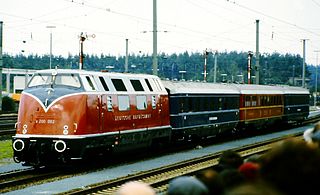
DB Class V 200 was the first series production diesel-hydraulic express locomotive of the German Deutsche Bundesbahn and – as Am 4/4 – of the SBB-CFF-FFS in Switzerland.

The DRG Class SVT 137 was a class of streamlined diesel train sets of the Deutsche Reichsbahn-Gesellschaft and later of the Deutsche Bundesbahn and the Deutsche Reichsbahn. With a regular maximum speed of 160 km/h (99 mph) and average speeds of up to 132 km/h (82 mph) they were the first high speed trains in central Europe.
NSB Class 88 was a class of six three-car diesel-hydraulic multiple units built by Strømmens Værksted for the Norwegian State Railways. Derived from the German DRG Class SVT 877, the trains were the diesel counterpart of Class 66. The trains were built as express trains on the Bergen Line and the Dovre Line, serving the routes from Oslo to Bergen and Trondheim. The first four units were delivered in 1945 and 1946, but mechanical failures caused them to highly unreliable until 1950. Two more units were delivered in 1958. Retirement started in 1963 and from 1965 the trains were moved to the Røros Line. They left regular service from 1970 and were chopped three years later.

German Kleinlokomotiven like the DRG Kö II were developed as locomotives with a low weight and driving power for light shunting duties. There were two classes, based on engine power. The Class II were engines which developed more than 40 HP.
The DRG locomotive classification system was developed by the German Imperial Railway Company or Deutsche Reichsbahn-Gesellschaft (DRG), which was formed in 1924 following the merger of the German state railways (Länderbahnen) in 1920. A common classification and numbering scheme was needed in order to organise effectively the four hundred or so different steam locomotive classes taken over from the state railways, as well as new locomotives. This process lasted until 1926. Only then was the final renumbering plan fixed.

The Uerdingen railbus is the common term for the multiple units which were developed by the German firm of Waggonfabrik Uerdingen for the Deutsche Bundesbahn and private railways after the Second World War. These vehicles were diesel-powered, twin-axle railbuses of light construction. The diesel motors were built into the chassis underneath the vehicle. The VT 95 and VT 98 of the former Deutsche Bundesbahn in particular, are associated with this concept. These vehicles were employed in passenger train duties on branch lines where steam or diesel train operations were less profitable. Including the units built under licence, a total of 1,492 power cars were built from 1950 to 1971; and the total number of units, including trailer and driving cars, was 3,306.

The DR locomotive classification scheme in East Germany in the initial post-war period used the DRG system, consisting of a class number (Baureihennummer) followed by a serial number (Ordnungsnummer). With the introduction of computerised (EDP) numbers in 1970 as part of the UIC framework, the system was fundamentally changed for the first time.
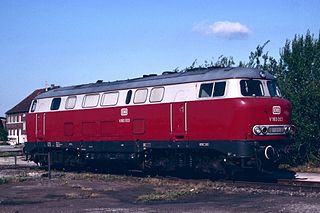
The Class V 160 is a class of diesel-hydraulic locomotives of the German railways. It is the first variant of the V160 family, built for the Deutsche Bundesbahn for medium/heavy trains.

The DB Class 218 are a class of 4-axle, diesel-hydraulic locomotives acquired by the Deutsche Bundesbahn for use on main and secondary lines for both passenger and freight trains.

DBAG Class 411 and Class 415 are German tilting electric multiple-unit high-speed trains in service with DB Fernverkehr, commonly known as ICE T.

The DBAG Class 605, commonly known as the ICE TD is a high-speed diesel multiple unit (DMU) train, formerly in service with Deutsche Bahn and DSB.
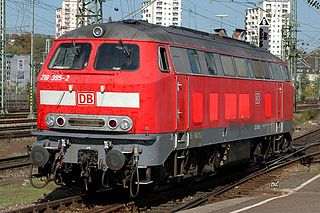
The DB V 160 locomotive family comprises several classes of closely related 4-axle diesel-hydraulic locomotives built in the 1960s and 1970s for the Deutsche Bundesbahn which take the family name from the earliest built model: the 'DB Class V 160'.
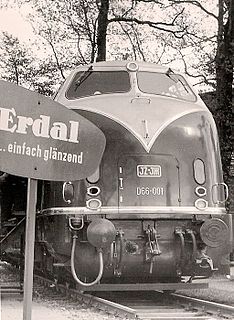
The diesel-hydraulic locomotive ML 2200 C'C' was a 6 axle variant of the DB Class V 200 series of locomotives, which were built for Yugoslav State Railways (JDŽ) by manufacturer Krauss-Maffei.
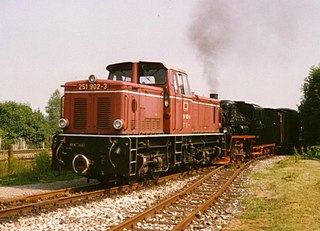
The DB Class V 51 and DB Class V 52 are classes of almost identical narrow gauge 4 axle diesel hydraulic locomotives built in 1964 for the Deutsche Bundesbahn, being built for 750 mm and 1,000 mm gauge lines respectively.
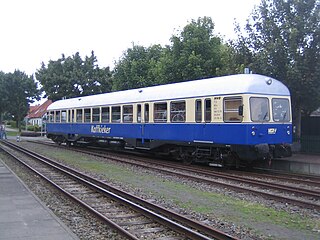
The MaK GDT is a large-volume diesel railbus that was first built in 1953 for private railways in Germany.

The Komet was an international overnight express train service between Germany and Switzerland, which was in operation from 1954 to 2016. Its name reflected the notion that the Comet train and an actual comet can both be described as travelling through the night at high speed. It was introduced in 1954. It became a EuroCity (EC) service upon the launch of the EC network in 1987. It became categorised as CityNightLine (CNL) service in the mid-1990s. With the decision by Deutsche Bahn to terminate all CNL services in December 2016, the Komet ran for the last time on 10–11 December 2016.
This page is based on this
Wikipedia article Text is available under the
CC BY-SA 4.0 license; additional terms may apply.
Images, videos and audio are available under their respective licenses.





















